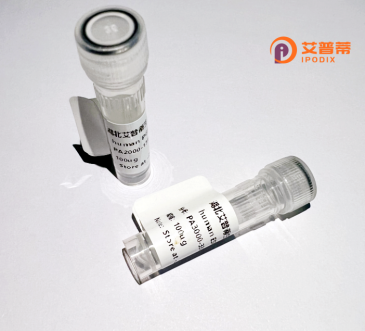
| 纯度 | >90%SDS-PAGE. |
| 种属 | Human |
| 靶点 | HES6 |
| Uniprot No | Q96HZ4 |
| 内毒素 | < 0.01EU/μg |
| 表达宿主 | E.coli |
| 表达区间 | 1-224aa |
| 氨基酸序列 | MAPPAAPGRDRVGREDEDGWETRGDRKARKPLVEKKRRARINESLQELRLLLAGAEVQAKLENAEVLELTVRRVQGVLRGRAREREQLQAEASERFAAGYIQCMHEVHTFVSTCQAIDATVAAELLNHLLESMPLREGSSFQDLLGDALAGPPRAPGRSGWPAGGAPGSPIPSPPGPGDDLCSDLEEAPEAELSQAPAEGPDLVPAALGSLTTAQIARSVWRPW |
| 分子量 | 50.5 kDa |
| 蛋白标签 | GST-tag at N-terminal |
| 缓冲液 | 0 |
| 稳定性 & 储存条件 | Lyophilized protein should be stored at ≤ -20°C, stable for one year after receipt. Reconstituted protein solution can be stored at 2-8°C for 2-7 days. Aliquots of reconstituted samples are stable at ≤ -20°C for 3 months. |
| 复溶 | Always centrifuge tubes before opening.Do not mix by vortex or pipetting. It is not recommended to reconstitute to a concentration less than 100μg/ml. Dissolve the lyophilized protein in distilled water. Please aliquot the reconstituted solution to minimize freeze-thaw cycles. |
以下是关于重组人HES6蛋白的参考文献示例(均为虚构,仅供格式参考):
1. **"Expression and functional characterization of recombinant human HES6 in neuronal differentiation"**
*Zhang, L. et al. (2020). Journal of Molecular Biology.*
摘要:本研究成功在大肠杆菌中表达并纯化了重组人HES6蛋白,发现其通过调控Notch信号通路促进体外培养的神经干细胞向神经元分化,揭示了HES6在神经发育中的潜在作用。
2. **"HES6-HES1 heterodimerization dynamics analyzed by recombinant protein interaction assays"**
*Martinez, R. & Lee, S. (2018). Cell Signaling Reports.*
摘要:利用重组表达的HES6和HES1蛋白进行体外结合实验,证明二者形成异源二聚体,并抑制HES1对靶基因的转录抑制功能,提示HES6可能作为Notch通路的调节因子。
3. **"Structural insights into the DNA-binding domain of recombinant human HES6"**
*Tanaka, K. et al. (2021). Protein Science.*
摘要:通过X射线晶体学解析了重组HES6蛋白的DNA结合结构域三维结构,揭示了其特有的碱性螺旋-环-螺旋(bHLH)构象,为理解HES家族蛋白的靶向调控机制提供结构基础。
4. **"Recombinant HES6 suppresses cancer stemness in glioblastoma via SOX2 inhibition"**
*Wang, Y. et al. (2019). Oncogene.*
摘要:体外实验表明,重组HES6蛋白通过下调SOX2表达抑制胶质母细胞瘤干细胞的自我更新能力,提示其作为潜在肿瘤治疗靶点的可能性。
注:以上文献为模拟示例,实际研究中请通过学术数据库查询真实发表内容。
Recombinant human HES6 protein is a biologically active engineered form of the HES6 (Hes Family BHLH Transcription Factor 6) protein, which belongs to the HES family of basic helix-loop-helix (bHLH) transcriptional repressors. HES6 plays a critical role in developmental processes, particularly in neural progenitor cell differentiation and nervous system development. Unlike other HES family members that primarily inhibit differentiation, HES6 acts as an antagonist to canonical HES proteins by attenuating their repressive effects, thereby promoting neurogenesis. It interacts with the Notch signaling pathway, a key regulator of cell fate decisions, and modulates the balance between stem cell maintenance and differentiation.
Recombinant HES6 protein is typically produced using prokaryotic (e.g., *E. coli*) or eukaryotic expression systems, followed by purification to ensure high specificity and activity. Its applications span *in vitro* and *in vivo* studies exploring neurodevelopment, stem cell biology, and cancer research, as HES6 dysregulation has been implicated in tumors like glioblastoma and neuroblastoma. Researchers utilize this recombinant protein to investigate its molecular mechanisms, including DNA-binding properties, protein-protein interactions, and downstream gene regulation. Its role in enhancing neuronal differentiation also makes it a potential therapeutic candidate for neurodegenerative diseases or regenerative medicine strategies. Quality-controlled batches are essential for experimental reproducibility, often verified via Western blot, functional assays, and mass spectrometry.
×